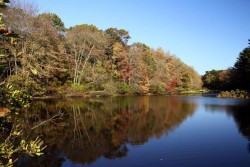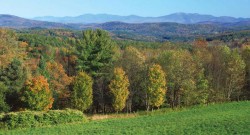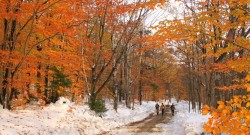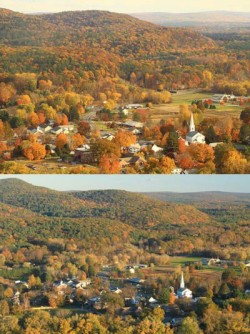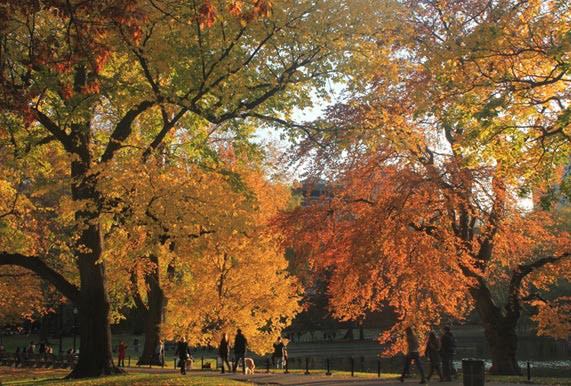
“Excuse me. Is this . . . the peak?” This query, from a perplexed tourist whose family had traveled from Italy to enjoy New England’s world-renowned foliage last fall, rather appropriately summed up the unusually drab autumn of 2011. Indeed, during my travels around New England, the lack of color was a regular topic of conversation. The ramifications of the poor season extended beyond aesthetics. Foliage tourism is a billion-dollar component of New England’s economy and October is an especially crucial month for the region’s travel-related businesses, many of which have suffered from the recession and Hurricane Irene.
While it was of little consolation to leaf peepers, the 2011 foliage season served as a useful reminder that leaf color is intricately related to weather and climate on both long- and short-term scales. Annual variations are the norm, especially given New England’s notoriously fickle climate – this is why forecasting “the peak” is tricky. The strange foliage of 2011 reflected a series of unusual weather events throughout the growing season, beginning with a spring that saw record precipitation and flooding in the Northeast.
Maples are arguably the region’s most iconic foliage species, and in 2011, the normally vibrant red and orange hues were conspicuously absent in many areas of the Northeast. Many maples were affected by anthracnose, a fungal disease that causes leaves to discolor and fall prematurely (symptoms include brown spots and markings on veins). It is present every year, but thrives during cold, wet springs such as last year’s. Ash, sycamore, oak, elm, birch, beech, and hickory all have their own form of anthracnose. Fortunately, though affected trees often look rather sickly and many people feared their ornamentals had died, anthracnose rarely kills trees.
In addition to anthracnose, many sugar maples were stressed by a high seed year. During these times, trees devote more energy and resources to ripening seeds at the expense of producing colorful red and orange pigments, especially in the seed-covered upper branches.
This process is evident in autumn when individual trees have colorful low branches with early leaf drop higher in the canopy.
As summer drew towards a close, a variety of other fungal diseases made their marks on the hillside. Aerial surveys in Vermont, for instance, documented 25,000 acres of birch defoliation caused by septoria leafspot. In southern New England, the winds of Hurricane Irene deposited ocean salt on trees and shrubs many miles inland, causing cell and tissue damage to leaves. The damage was greatest in Rhode Island and southeastern Massachusetts, on the east side of the storm track, which receives less precipitation in tropical storms than areas to the west; here there was little rainfall to rinse trees and mitigate the effects of the salt. Late-dropping species such as oak and beech lost their leaves as much as two months early.
Where leaves were left undamaged by fungi or insects, they were affected (or perhaps more accurately unaffected) by abnormal weather. Autumn 2011 began with a prolonged period of unseasonably mild weather, including a summery Columbus Day weekend when temperatures soared into the 80s. While the weather was ideal for hiking and traveling, the lack of cold, frosty nights significantly delayed the onset of fall foliage in many areas. After an abrupt interruption from yet another unusual event – the Halloween blizzard that caused widespread forest damage and power outages – the mild weather resumed and continued into the winter months. Groves of oaks and beeches offered colorful displays well into November in areas of southern New England, and in the greater Boston area foliage was visible on some trees as late as the week before Christmas.
While the mild autumn of 2011 was related to a global La Niña event, when cool Pacific Ocean temperatures cause warm, moist conditions in the Northeast, it also was consistent with a long-term climate trend. According to data recorded by the weather station at Harvard Forest in central Massachusetts, the date of the first frost has become progressively later over the past half-century, especially during the past 20 years. Research and observations by Dr. John O’Keefe, who has been monitoring phenology (the relationship between phenomena and climate) at Harvard Forest for the past 23 years, show that several species have been dropping their leaves later during this time.
So far, the weather in the months leading up to the 2012 foliage season has been the opposite of that in 2011, with record-breaking warmth and below-average precipitation, apart from a short rainy period in mid-spring. These conditions bode well for preventing a repeat of the fungal diseases that were widespread in 2011, though a prolonged dry spell can cause stressed leaves to brown and fall prematurely. The National Weather Service Climate Prediction Center’s long-term forecasts indicate that above-normal temperatures are likely to continue in the Northeast through the autumn, which would likely continue the trend of late foliage. The general prognosis looks favorable for a vibrant season, though the region’s capricious weather will be the final variable.


